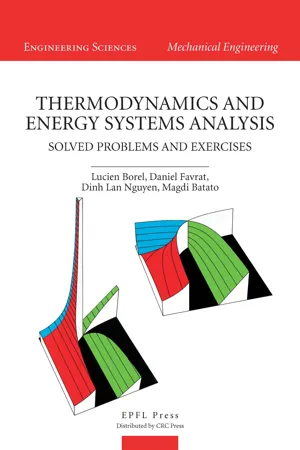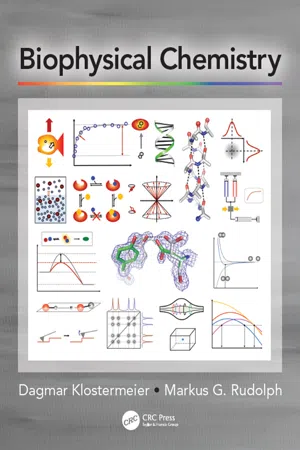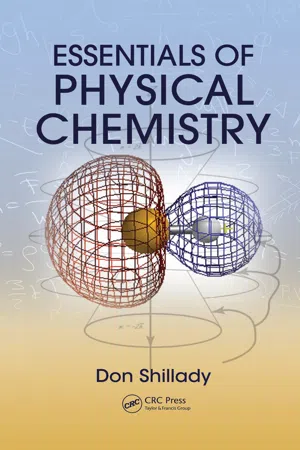Technology & Engineering
Adiabatic Expansion of an Ideal Gas
Adiabatic expansion of an ideal gas refers to a process in which a gas expands without gaining or losing heat to its surroundings. This results in a decrease in the gas's pressure and temperature. The process is characterized by the equation PV^γ = constant, where P is pressure, V is volume, and γ is the heat capacity ratio.
Written by Perlego with AI-assistance
Related key terms
1 of 5
5 Key excerpts on "Adiabatic Expansion of an Ideal Gas"
- eBook - PDF
- Lucien Borel, Daniel Favrat, Dinh Lan Nguyen, Magdi Batato(Authors)
- 2012(Publication Date)
- EPFL PRESS(Publisher)
Chapter 8 Thermodynamic processes and diagrams 8.A Adiabatic Expansion of an Ideal Gas Description A mass of air M is expanded from an initial state 1 to a final state 2 in the power system represented in Figure 8.1. Hypotheses • The cylinder is thermally insulated. • The changes of the kinetic and potential energies are negligible. • The process is done without dissipation. • The isobaric specific heat of air is given by a polynomial of the type: c p = 5 X i=1 a i T i-1 where a i are constants. • The air can be considered as an ideal gas. Data • Initial thermodynamic state: V 1 = 0.25 · 10 -3 m 3 P 1 = 100 bar ˆ T 1 = 500 ◦ C • Final volume: V 2 = 2.5 · 10 -3 m 3 • Specific constant of air: r = 0.2882 kJ/(K kg) • Constants of the polynomial of the specific heat: c p in kJ/(K kg) T in K a 1 a 2 a 3 a 4 a 5 1 057.69 -462.92 · 10 -3 1 182.59 · 10 -6 -835.11 · 10 -9 198.8 · 10 -12 232 Adiabatic Expansion of an Ideal Gas Questions • Calculate the mass of air. • Determine the final thermodynamic state (P 2 , T 2 ). • Calculate the work supplied by the expansion. Figure 8.1 Solution Mass of air The equation of state of ideal gases (5.72) gives the mass of air: M = V 1 P 1 rT 1 = 11.2 · 10 -3 kg Thermodynamic processes and diagrams 233 Final thermodynamic state Considering (2.2) and the first and third hypotheses, the process 1-2 is isen- tropic. - No longer available |Learn more
- Dagmar Klostermeier, Markus G. Rudolph(Authors)
- 2018(Publication Date)
- CRC Press(Publisher)
16 Chapter 2 . State Functions and the Laws of Thermodynamics From Figure 2.10 , we see that the work performed during a reversible expansion constitutes an upper limit for the work performed by the system: w w re v i rrev ≥ eq. 2.16 For the compression, on the other hand, the work performed under reversible conditions is a lower boundary for the work performed on the system: w w re v i rrev ≤ eq. 2.17 In other words, for a real process that is not entirely reversible, the work w irrev the system performs is most likely smaller than w rev , whereas the work we have to perform on a system is most likely larger. This relation does not only apply to state changes of gases but to all processes: in general, we can have a system perform more work on the way from state 1 to state 2 if changes are reversible. We will come back to this in Section 2.4.2 . 2.2.4.4 Adiabatic Expansion and Compression So far, we have considered volume changes of an ideal gas under isothermal conditions, where the temperature of the gas remains constant because the gas is coupled to a large heat reservoir, such that heat released by the gas is taken up by the reservoir, and heat taken up by the gas is removed from the reservoir. We can also change the state of an ideal gas without allowing heat exchange with the surroundings. A change in state without heat exchange is called an adiabatic process . In this case, the temperature of the system will change. Upon expansion, the system cannot take up heat from the surroundings, and the temperature will decrease. Conversely, upon compression, no heat can be released, and the temperature of the system will increase. Adiabatic compression of air masses crossing a mountain range is the reason for warm winds in the valleys ( Box 2.3 ). BOX 2.3: ADIABATIC COMPRESSION OF AIR MASSES GENERATES DRY, WARM WINDS . When winds move air towards high mountains, the air masses ascend to higher levels. They thereby reach regions with lower air pressure, and expand. - eBook - PDF
- Michael A. Box, Gail P. Box(Authors)
- 2015(Publication Date)
- CRC Press(Publisher)
2.3.3 ADIABATIC PROCESSES Many important thermodynamic processes take place under well-defined, restricted circumstances. We may define the following: ∞ An isobaric process is one taking place at constant pressure. ∞ An isothermal process is one taking place at con-stant temperature. ∞ An adiabatic process is one taking place in such a way that there is no exchange of heat between the system and its environment, and no phase changes are occurring. 32 Physics of Radiation and Climate Consider the adiabatic expansion of a gas. The First Law of Thermodynamics becomes du dw = -. Since the work done is positive, u must decrease, and so must T. We now use Equation 2.40 – another form of the First Law – and also the ideal gas equation, to obtain dq T c dT T dp T c dT T R dp p p p º = -= -0 a We may now integrate this equation from some initial state, defined by ( p 0 , T 0 ), to a final state defined by ( p, T ), obtaining ln ln T R c p T T p p p 0 0 = And hence, T T p p 0 0 = æ è ç ö ø ÷ k (2.45) where κ = R / c p = 0.286. Equation 2.45 is known as Poisson’s equation. We may derive two other versions of this result if we use the ideal gas equation: T T 0 0 1 = æ è ç ö ø ÷ -r r g (2.46) and p p 0 0 = æ è ç ö ø ÷ r r g (2.47) These are clearly of limited use in the atmosphere as we usually seek to remove density from our equations at the first opportunity . 2.3.3.1 POTENTIAL TEMPERATURE Poisson’s equation is the basis of the important concept of potential temperature. The potential temperature of a parcel of (dry or unsaturated) air, θ , is the temperature that air would have if it was brought adiabatically from its current temperature, T , and pressure, p , to a reference pressure level of 1000 hPa. Hence, q k = æ è ç ö ø ÷ T p 1000 (2.48) By this (physical) definition, we see that the potential temperature of an air parcel is conserved during an adiabatic process. - eBook - PDF
- R. Prasad(Author)
- 2016(Publication Date)
- Cambridge University Press(Publisher)
How much is the heat flow in this case? 12. Show that in the reversible isobaric expansion of an ideal gas the gas temperature also gets doubled to the initial value if the final volume is twice the original volume. 13. A fixed amount of an ideal gas is enclosed in a diathermic boundary which is surrounded by an adiabatic tank of some fluid. The liquid in the adiabatic tank is very slowly heated by passing electric current through a resistance immersed in the liquid. The temperatures of the liquid as well as of the ideal gas increases slowly. In what respect the temperature rise of the gas is different from that of the liquid? 14. In what respect the adiabatic work between two equilibrium states of a system of same bulk energy is different from the isothermal or isobaric work? 15. How the change in the internal energy of a system may be related to the adiabatic work? Long Answer Questions 1. State and explain the first law of thermodynamics and hence define the internal energy and the heat flow for the system. 2. Discuss with necessary details the thermodynamic temperature and explain why it is most fundamental or absolute. 3. Describe the working of a Carnot cycle, discuss its significance and derive expressions for the efficiency of an ideal heat engine as well as the performance coefficient of a refrigerator. What are the important characteristics of the Carnot cycle? 4. Starting from the definitions of the thermal heat capacities obtain the relation C C P V - = ∂ ∂ ( ) + È Î Í ˘ ˚ ˙ ∂ ∂ ( ) U V P V T T P 5. Derive the following thermodynamic relations, 1. c P = ∂ ∂ ( ) h T P , First Law of Thermodynamics and some of its Applications 189 2. c T v h v P P p ∂ ∂ ( ) = ∂ ∂ ( ) 3. c P v c P v P T v adi ∂ ∂ ( ) = ∂ ∂ ( ) where symbols have their usual meaning. 6. What was the aim of porous plug experiment? Give a detailed description of the experimental setup and show that enthalpy does not change during the adiabatic expansion of the gas through the porous plug. - eBook - PDF
- Don Shillady(Author)
- 2011(Publication Date)
- CRC Press(Publisher)
Some texts stop here but this is not our favorite form of analysis for a diesel engine. We can show an example as an aside to illustrate the important application of adiabatic nozzle expansion for low-temperature spectroscopy. Much of the history of this technique is included in the Nobel Address of J. B. Fenn [6]. ADIABATIC NOZZLE EXPANSION SPECTROSCOPY [7] A recently discovered way to simplify complex electromagnetic spectra of molecules is to sweep a high-pressure stream of He gas across the sample and carry it to exit into the sample chamber of a spectrometer at a much lower pressure (nominally 1 atm) whereupon the He and the sample will drastically cool and this innovation in spectroscopy has resulted in some remarkably sharp spectral details being resolved in otherwise broad spectral blurs at room temperature. However, the He must be precooled to below 51 8 K, which is its Joule – Thomson inversion temperature. For simplicity we can consider N 2 gas to illustrate the same point. 64 Essentials of Physical Chemistry Example Consider the expansion of 100 mL of N 2 gas at 100 atm in a gas bottle at 30 8 C to 1 atm of pressure through a nozzle so rapidly as to achieve an adiabatic process. What is the temperature of the expanded N 2 if the fi nal volume is 10 L? N 2 is very close to a diatomic ideal gas, so we use C V ¼ 5 2 R , 3 R 2 translation plus 2 R 2 rotation and raise the whole equation to the R C V power to fi nd the ratio of the temperatures as T 2 T 1 C V R ð Þ ¼ V 1 V 2 # R C V to solve for the ratio of temperatures as T 2 T 1 ¼ V 1 V 2 R C V , so we fi nd that T 2 ¼ T 1 V 1 V 2 R C V ¼ ( 303 : 15 K) 0 : 100 10 : 0 1 R 2 : 5 R ð Þ ¼ 48 : 046 K . This rapid adiabatic expansion is suf fi cient to cool the nitrogen to below its boiling point of 77 8 K, so this is a way to make liquid nitrogen.
Index pages curate the most relevant extracts from our library of academic textbooks. They’ve been created using an in-house natural language model (NLM), each adding context and meaning to key research topics.




